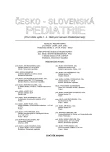Non-drug Poisoning in Children Hospitalized in Children Faculty Hospital in Bratislava in the Years 1996–2000
Neliekové intoxikácie u detí hospitalizovaných v Detskej fakultnej nemocnici v Bratislave v rokoch 1996–2000
Autori v práci analyzovali neliekové intoxikácie detí, ktoré boli s touto diagnózou hospitalizované na I. a II. detskej klinike LFUK a Detskej klinike anesteziológie a intenzívnej medicíny (DKAIM) Detskej fakultnej nemocnice s poliklinikou v Bratislave. Za obdobie rokov 1996–2000 sa zaznamenalo 336 neliekových intoxikácií, čo predstavuje 53,2 % z celkového počtu intoxikácií hospitalizovaných detských pacientov s touto diagnózou. Najpočetnejšiu vekovú skupinu súboru (34,8 %) predstavovali 15–18-roční pacienti. Požitie alkoholu bolo najčastejšou príčinou neliekových intoxikácií detských pacientov (44 %). Detskí pacienti a adolescenti mali najčastejšie 1,5–2,0 promile alkoholu v krvi, hodnoty nad 3,0 promile alkoholu v krvi sa zaznamenali u 4 pacientov. Chemikálie (26 %), rastliny (12 %), drogy (8 %) a huby (8 %) boli častou príčinou neliekových intoxikácií detí. Požitie durmanu obyčajného, jedu na potkany a aromatického lampového oleja viedlo k značnému počtu hospitalizácií detských pacientov. V analyzovanom súbore sa zistilo 95 závažných intoxikácií, 4 prípady ťažkej intoxikácie a 3 smrteľné intoxikácie po požití húb.
Kľúčové slová:
neliekové intoxikácie, deti, stupne závažnosti otráv
Authors:
M. Kuželová 1; J. Seginko 1; S. Plačková 2; L. Kovács 3; M. Benedeková 4; R. Riedel 5; P. Švec 1
Authors‘ workplace:
Katedra farmakológie a toxikológie FaFUK, Bratislava
vedúci prof. MUDr. P. Švec, DrSc.
Toxikologické informačné centrum, Klinika pracovného lekárstva a toxikológie LFUK, FNsP
1; akad. L. Dérera, Bratislava
vedúca PharmDr. S. Plačková, MPH
2; II. detská klinika LFUK, DFNsP, Bratislava
prednosta prof. MUDr. L. Kovács, DrSc., MPH
3; I. detská klinika LFUK, DFNsP, Bratislava
prednostka doc. MUDr. M. Benedeková, PhD.
4; Detská klinika anesteziológie a intenzívnej medicíny SZU DFNsP, Bratislava
prednosta prof. MUDr. T. Šagát, CSc.
5
Published in:
Čes-slov Pediat 2005; 60 (2): 47-53.
Category:
Original Papers
Overview
The authors analyzed cases of non-drug poisoning in children, who have been hospitalized with this diagnosis at the 1st and 2nd Children Clinic of Medical Faculty, Komensky University and Children Clinic of Anesthesiology and Intensive Medicine with Policlinic in Bratislava. In the period of 1996–2000 there were 336 cases of non-drug poisoning, representing 53.2% of all cases of intoxications of hospitalized child patients with this kind of diagnosis. Patients at the age of 15–18 years represented the most frequent age group (34.8%). Alcohol abuse was the most frequent non-drug intoxication in child patients (44%). The blood level of alcohol in the child patients and adolescents was most frequently 1.5–2.0 per thousand, while values of alcohol above 3.0 per thousand were determined in four patients. Chemicals (26%), plants (12%), drugs of abuse (8%), mushrooms (8%) were frequent causes of non-drug poisoning in children. The use of thorn-apple, rat poison and aromatic lamp oil resulted in a significant number of hospitalizations of child patients. In the analyzed cohort there were 95 serious intoxications, four cases of severe intoxications and three fatal poisoning after ingestion of mushrooms.
Key words:
non-drug poisoning, children, degree of poisoning seriousness
Labels
Neonatology Paediatrics General practitioner for children and adolescentsArticle was published in
Czech-Slovak Pediatrics

2005 Issue 2
- What Effect Can Be Expected from Limosilactobacillus reuteri in Mucositis and Peri-Implantitis?
- The Importance of Limosilactobacillus reuteri in Administration to Diabetics with Gingivitis
Most read in this issue
- Mannose-binding Lectin Deficiency
- Diarrhea Diseases in Hospitalized Children up to 5 Years of Age
- Non-drug Poisoning in Children Hospitalized in Children Faculty Hospital in Bratislava in the Years 1996–2000
- Prenatal Exposure to Cigarette Smoke and Behaviour of Children in 18 Months of Age. Results of ELSPAC Study
